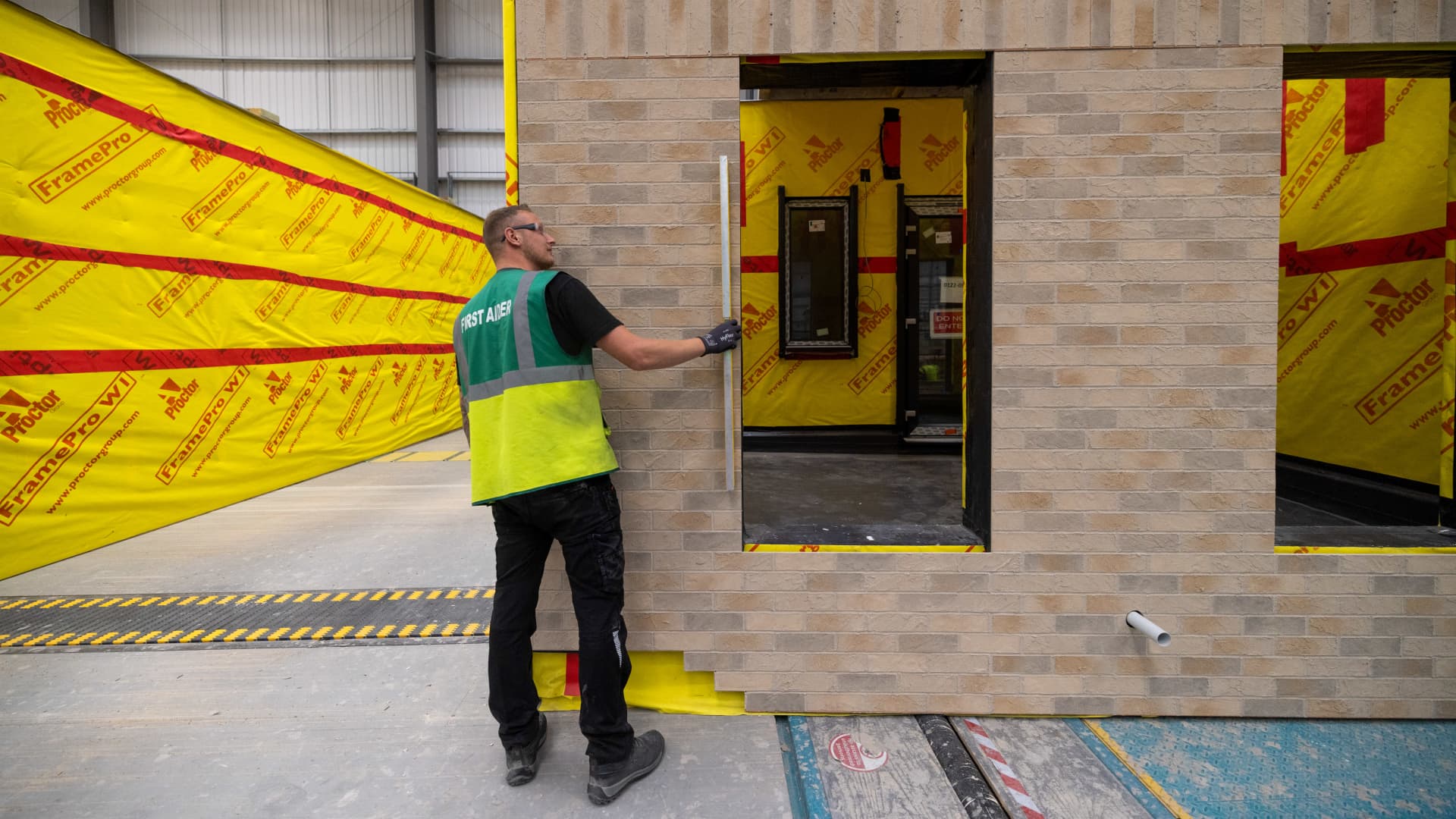Modular homes were hailed as a solution to housing crises. But the sector is now struggling to scale
6 min read
An employee checks the external casing with a spirit level in a modular house at the Tophat factory in Foston near Derby, UK, on Tuesday, Sept. 12, 2023.
Bloomberg | Bloomberg | Getty Images
The idea of using pre-assembled components in housebuilding is far from new.
Modern tech-enabled versions of modular housing promise a faster, more sustainable solution to housing crises, according to experts. But the sector has seen better adoption in some countries compared to others where it has failed to scale — such as the U.K.
Prefabrication has existed in many forms, from the defenses used by William the Conqueror in his invasion of England in 1066 to Sears’ mail-order homes in the U.S. in the early 1900s.
Fast forward a century and entire modules can be built in factories to then be combined to create houses in just weeks. Speed is just one advantage that modular homes offer compared with traditional construction, a factor which is key in countries such as the U.K. which continues to face shortages of affordable housing.
The fact that modular housing is also made in a controlled factory environment means less waste is generated, while also resulting in more energy-efficient homes. Andrew Shepherd, managing director at British modular developer TopHat Communities, told CNBC that the firm’s factory had sent “zero waste to landfill” in the last three years.
Building entire sections in one place also means fewer delivery trips to sites, Shepherd explained. A 2022 report from industry group Make UK Modular highlighted that 80% fewer vehicle movements were needed to development sites with modular building.
Another study by academics at the University of Cambridge and Edinburgh Napier University, published in 2022, found that modular home construction can result in 45% less embodied carbon. This refers to the emissions generated in the construction process, including the making and transportation of materials.
‘A very tough business’
Despite these benefits, the sector has seen a number of setbacks in recent years and it remains relatively nascent in the U.K. and U.S.
In January, it was reported that U.K. firm Modulous had entered into liquidation after failing to find a buyer. In the U.K. last year, Ilke Homes collapsed, while Legal & General moved to wind down its modular housing factory. One of the most high-profile failures in the sector was SoftBank-backed Katerra in the U.S., which filed for bankruptcy in 2021.
Jonatan Pinkse, professor of sustainable business at King’s College London, highlighted that part of the challenge for modular construction firms is that they first have to spend money on building a factory in which to construct modules and then need to have the projects in the pipeline to pay for this investment.
He suggested that this presented more difficulty when coupled with the headwinds that also affected the wider construction sector, including higher energy costs and interest rates, as well as a cost-of-living crisis in many nations prompting people to hold off on house buying.
“And if you then can’t profit from a market that is actually going up, but instead is going down, then the problem is simply that [firms] can’t earn back their money fast enough, and investors then lose their trust in the business model,” Pinkse told CNBC.
Pinkse was one of the co-authors on research, published last year, which highlighted some of the issues limiting the use of modular, also known as 3D (volumetric) factory-manufactured modular homes, as the most advanced form of modern methods of construction (MMC).

Suzanne Peters, who also co-authored the research and is a research associate at Alliance Manchester Business School, told CNBC that the construction sector more broadly is a “very tough business” with a higher amount of failures versus other industries. Provisional data from the U.K.’s Insolvency Service, published in January, showed that the construction industry experienced the highest number of insolvencies of any sector in England and Wales in 2023, with 4,371 companies going bust. This equated to nearly one in five insolvencies.
Similarly, Daniel Paterson, director of government affairs at Make UK Modular, said that the modular housing sector had faced a “series of unfortunate events,” as the industry had essentially only launched in the U.K. in its current format in 2016/17. He explained that firms then need around 18 months to build factories, meaning it wasn’t long before the Covid-19 pandemic hit, along with the economic headwinds that followed.
Perceptions based on previous versions of prefabrication was another issue, according to Richard Valentine-Selsey, head of European living research and consultancy at Savills Research.
He told CNBC that, in the U.K., there is the “1960s hangover from prefabrication and the kind of connotations that has with lower quality, things that don’t last and all the kind of negative impacts of that from the building boom post-war.”
In addition, he said that the “construction industry is quite a conservative beast and finds it very challenging at times to change and think forward and innovate unless their forced to do it, which has kind of led to flirtation with new methods but no kind of wholesale change towards delivering using modular.”
Leaders in modular
Sweden and Japan are the countries cited as leaders in prefabrication. Savills Research highlighted in 2020 that 45% of homes in Sweden were built using offsite construction. In Japan, it said MMC was used in building 15-20% of new homes, though that still equated to between 150,000 and 180,000 homes a year.
By comparison, a Make UK Modular report published last year said more than 3,000 modular homes were being built in the U.K. annually, though there was capacity to build five times that number. A 2023 McKinsey & Company report, meanwhile, said that less than 4% of current U.S. housing stock had been built using modular methods.
In Sweden, one of the major players in this space is BoKlok, which is jointly owned by construction firm Skanska and homes and furniture company Ikea, and has been around since the mid-1990s.
A crane lifts a prefabricated residential housing module onto an apartment block at a modular rental property construction site, operated by Vonovia SE, in Berlin, Germany, on Thursday, Sept. 26, 2019.
Bloomberg | Bloomberg | Getty Images
Shepherd pointed out that Sweden is also “not a country where you can build 12 months of the year.”
“They have very deep winters with limited daylight, so there is an incentive to look at an alternative construction process to keep people working all year, to get houses delivered at the volume needed,” he explained.
Valentine-Selsey said that in Japan there was also a difference in the approach to residential buildings. “In Japan, the value of the building depreciates over about 30 years, so by the end of that you kind of knock it down and rebuild it because it is worthless,” he explained, making new building methods useful, given that the delivery of new homes is higher.
Optimistic outlook
Looking at these examples, could methods such as modular help tackle the U.K.’s affordable housing shortage?
The current U.K. government has the target of building 300,000 homes a year, but 234,400 were built in 2022-23. Keir Starmer, the leader of the U.K.’s opposition Labour party, has pledged to build 1.5 million homes within a five-year term if his party is elected.
“That’s 300,000 houses a year, and there is zero chance … of that happening if there is not some form different approach adopted,” Shepherd said.
Looking ahead, Valentine-Selsey said he was an “optimist” in his outlook for the modular sector. “I think we’re probably going to see an uptake again over the next five to 10 years,” he said.
However, he believed that greater adoption of other types of MMC, such as panelized solutions, was more likely, but thought “modular will form part of that new mix of delivery.”








